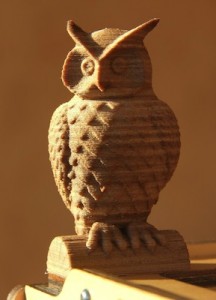When it comes to 3D printing and the materials that can currently be printed in a home environment, the range available might surprise you. Of course there are technical capabilities and limitations to the home printers, but lets focus on the materials for now.
Jeremy Francois recently wrote a great post on the 3D printer improvements blog about materials that have been used successfully in a home environment, which has informed this post together with further data obtained through the open source communities. The list is not exhaustive — and it is certain to keep growing over time.
PLA: environmentally-friendly filament

As a 3D printing material PLA is strong and resists UV light better than ABS plastic. It’s greener than most materials, with the exceptions of clay, chocolate and wood. However, it should be noted that if you are using PLA for dining applications such as cups or plates, some of the colour pigments may contain toxins.
PLA in its natural state is transparent, but colour choices for PLA vary making it suitable for creating toys and artistic items. Blending different colors is also possible.
PLA usually prints well at 220°, releases no toxic fumes and smells like pancakes. It stays flatter and sticks to the printer bed better than other plastics,when the material cools down. It’s also easy to re-heat PLA with a lighter or a hot air gun for example, in order to repair, bend or attach pieces together. However, finishing PLA is more difficult than ABS, for example.
ABS plastic

Cold ABS is slightly more flexible than PLA: it stretches before it breaks, making it better suited for some applications. However, sunlight and ABS don’t really get along: UV makes it riddle, and therefore it is best avoided for outdoor applications.
ABS prints at a slightly higher temperature than PLA (245°), but it releases toxic fumes during the process and requires ventilation. Although there has been some debate as to whether it is really dangerous or not.
Finished objects can be attached together with glue or softened with petroleum solvents, which also gives it a polished look. ABS has more post-process and paint options than PLA.
Water-soluble plastic: PVA
PVA is mainly used as a temporary support structure material in dual-head printers, where one head prints the PVA structure and the other prints the permanent plastic. When the object is submersed in water the PVA dissolves.
The cool thing about PVA material is that it makes printing impossible shapes possible. However, as a material it is expensive and is so sensitive to water that even air moisture can cause it to deteriorate! Proper seals for storing is recommended.
Cheaper option: Nylon

The print temperature is high ranging from 245° to 300°, and like ABS, nylon also releases toxic fumes during the printing process.
Colour choices are not as extensive as for PLA and ABS, but Nylon has its nuances when it comes to colours, making it suitable for gears or phone cases.
Some recommend drying the filament before use, as it tends to retain moisture. Printing with non-dry nylon filament can result in a ruined print.
Ethylene and Polycarbonate
There are many other oil-based thermoplastic materials available for 3D printing with entry-level printers. The polyethylene family is a suitable material range for applications such as bottle caps, food storage containers and chemical resistant piping.
An entry -evel 3D printer could use any thermoplastic that melts and can be shaped into a filament as the print material. What really limits use, though, is the requirement for very high extrusion temperatures, as the extruders on entry level 3D printers are limited to around 300°F. Higher temperatures are not fire and toxic fume safe.
Polycarbonate is a material worth mentioning because of its durability and useful applications: think of a CD or DVD. The material can be printed crystal clear, however low temperatures can degrade it.
Wood-based filament

What is positive about it is that the print texture is simply beautiful and it hides print layers nicely, without making extremely thin layers. By varying the extrusion temperature it is possible to create different shades of brown.
The only brand available at the moment is LAYWOOD, and the manufacturers spent over a year on research and development of the material.
Printing pastes
3D printing pastes, made from materials such as sugar, chocolate, silicone, wax and clay have been widely explored and the results are starting to show. However, the print head requires modification in order to extrude solidifying pastes. The hot end has to be swapped with, for example, a syringe, a peristaltic pump and/or an auger screw.
Wax is one of the intriguing materials in this class. Wax material applications can be taken beyond printing candles into printing moulds, such as for lost-wax casting or injected moulding.
Printing with pastes is still under very much an experimental activity. Every paste material seems to have its own unique challenges to be overcome, and so far printing pastes is still quite difficult and messy. Have a look at the video of printing clay.
Materials development is generally considered to be the key area that is holding back much wider adoption of 3D printing — particularly in the consumer space. However, as you can see, the continued extensive development is sure to bring new and exciting applications. We look forward to bringing them to you here.
Source: 3D Printer Improvements



